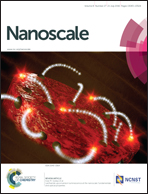Direct imaging of rotating molecules anchored on graphene†
Abstract
There has been significant research interest in controlling and imaging molecular dynamics, such as translational and rotational motions, especially at a single molecular level. Here we applied aberration-corrected transmission electron microscopy (ACTEM) to actuate and directly image the rotational motions of molecules anchored on a single-layer-graphene sheet. Nanometer-sized carbonaceous molecules anchored on graphene provide ideal systems for monitoring rotational motions via ACTEM. We observed the preferential registry of longer molecular axis along graphene zigzag or armchair lattice directions due to the stacking-dependent molecule-graphene energy landscape. The calculated cross section from elastic scattering theory was used to experimentally estimate the rotational energy barriers of molecules on graphene. The observed energy barrier was within the range of 1.5–12 meV per atom, which is in good agreement with previous calculation results. We also performed molecular dynamics simulations, which revealed that the edge atoms of the molecule form stably bonds to graphene defects and can serve as a pivot point for rotational dynamics. Our study demonstrates the versatility of ACTEM for the investigation of molecular dynamics and configuration-dependent energetics at a single molecular level.


 Please wait while we load your content...
Please wait while we load your content...